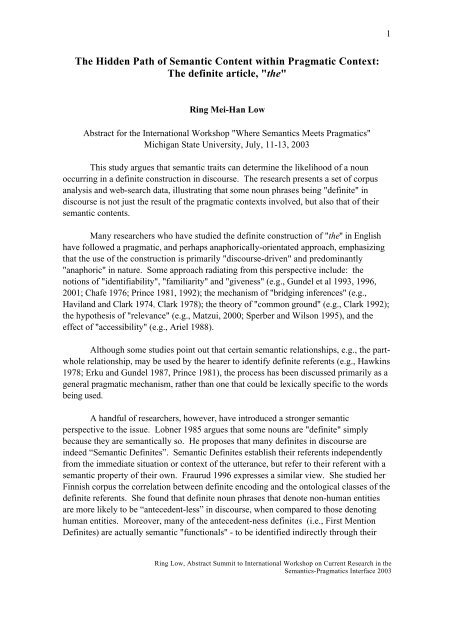SemPrag03.Progr.pdf - Institut für Linguistik/Germanistik - Universität ...
SemPrag03.Progr.pdf - Institut für Linguistik/Germanistik - Universität ...
SemPrag03.Progr.pdf - Institut für Linguistik/Germanistik - Universität ...
You also want an ePaper? Increase the reach of your titles
YUMPU automatically turns print PDFs into web optimized ePapers that Google loves.
1<br />
The Hidden Path of Semantic Content within Pragmatic Context:<br />
The definite article, "the"<br />
Ring Mei-Han Low<br />
Abstract for the International Workshop "Where Semantics Meets Pragmatics"<br />
Michigan State University, July, 11-13, 2003<br />
This study argues that semantic traits can determine the likelihood of a noun<br />
occurring in a definite construction in discourse. The research presents a set of corpus<br />
analysis and web-search data, illustrating that some noun phrases being "definite" in<br />
discourse is not just the result of the pragmatic contexts involved, but also that of their<br />
semantic contents.<br />
Many researchers who have studied the definite construction of "the" in English<br />
have followed a pragmatic, and perhaps anaphorically-orientated approach, emphasizing<br />
that the use of the construction is primarily "discourse-driven" and predominantly<br />
"anaphoric" in nature. Some approach radiating from this perspective include: the<br />
notions of "identifiability", "familiarity" and "giveness" (e.g., Gundel et al 1993, 1996,<br />
2001; Chafe 1976; Prince 1981, 1992); the mechanism of "bridging inferences" (e.g.,<br />
Haviland and Clark 1974, Clark 1978); the theory of "common ground" (e.g., Clark 1992);<br />
the hypothesis of "relevance" (e.g., Matzui, 2000; Sperber and Wilson 1995), and the<br />
effect of "accessibility" (e.g., Ariel 1988).<br />
Although some studies point out that certain semantic relationships, e.g., the partwhole<br />
relationship, may be used by the hearer to identify definite referents (e.g., Hawkins<br />
1978; Erku and Gundel 1987, Prince 1981), the process has been discussed primarily as a<br />
general pragmatic mechanism, rather than one that could be lexically specific to the words<br />
being used.<br />
A handful of researchers, however, have introduced a stronger semantic<br />
perspective to the issue. Lobner 1985 argues that some nouns are "definite" simply<br />
because they are semantically so. He proposes that many definites in discourse are<br />
indeed “Semantic Definites”. Semantic Definites establish their referents independently<br />
from the immediate situation or context of the utterance, but refer to their referent with a<br />
semantic property of their own. Fraurud 1996 expresses a similar view. She studied her<br />
Finnish corpus the correlation between definite encoding and the ontological classes of the<br />
definite referents. She found that definite noun phrases that denote non-human entities<br />
are more likely to be “antecedent-less” in discourse, when compared to those denoting<br />
human entities. Moreover, many of the antecedent-ness definites (i.e., First Mention<br />
Definites) are actually semantic "functionals" - to be identified indirectly through their<br />
Ring Low, Abstract Summit to International Workshop on Current Research in the<br />
Semantics-Pragmatics Interface 2003

















